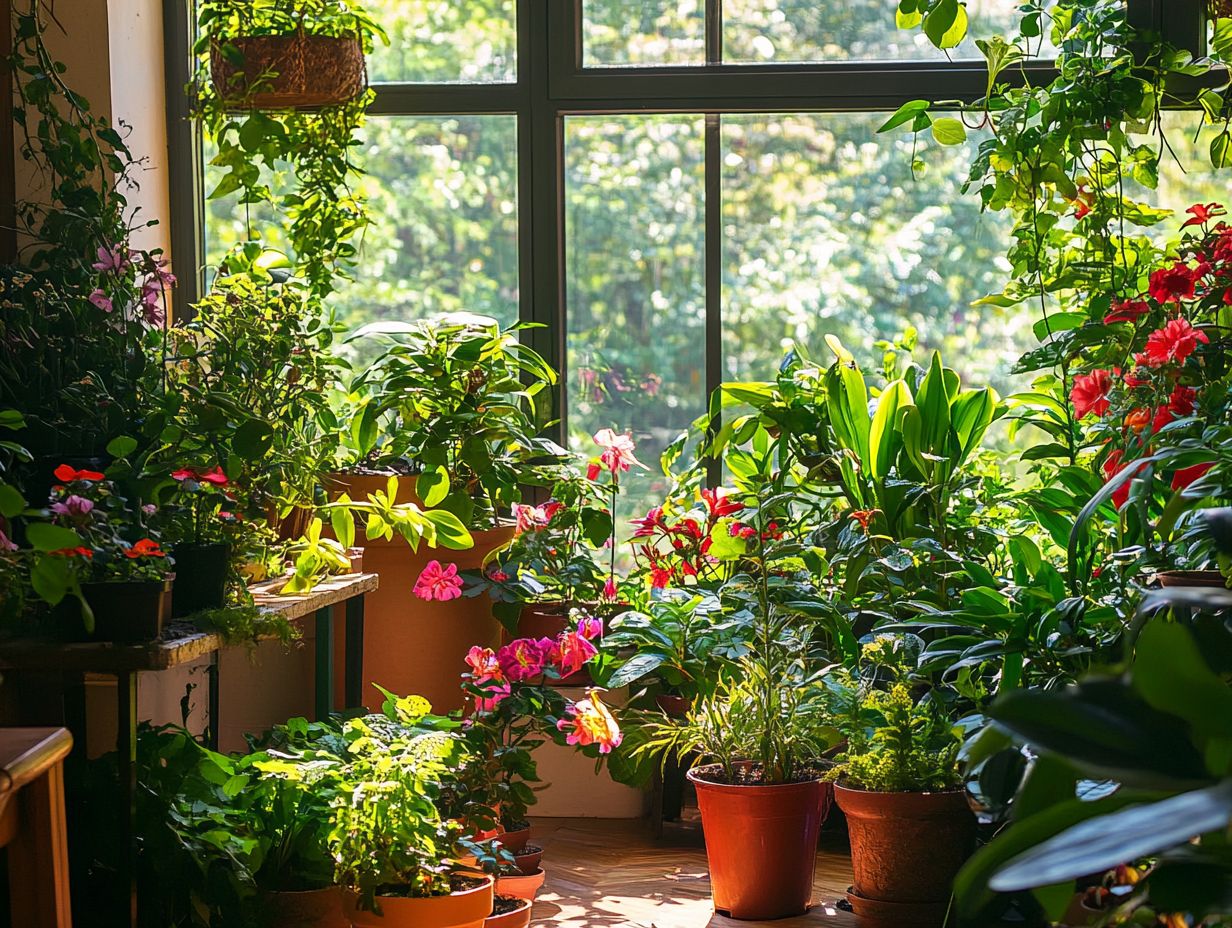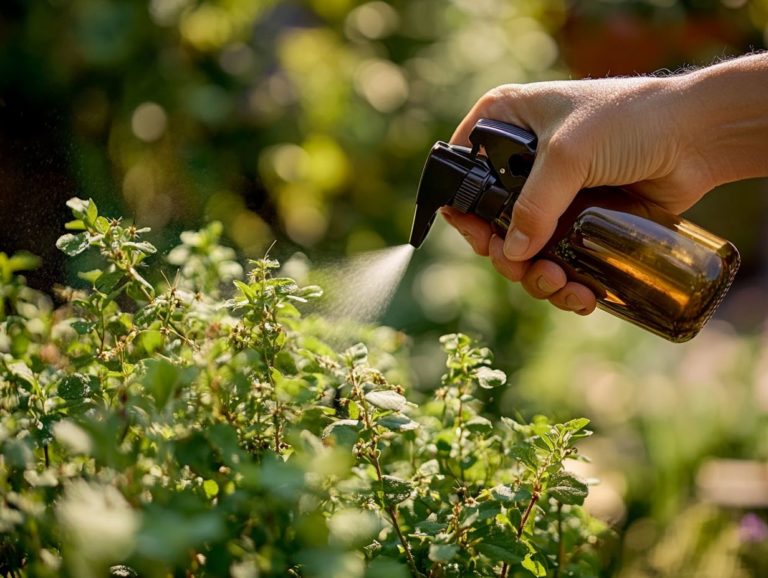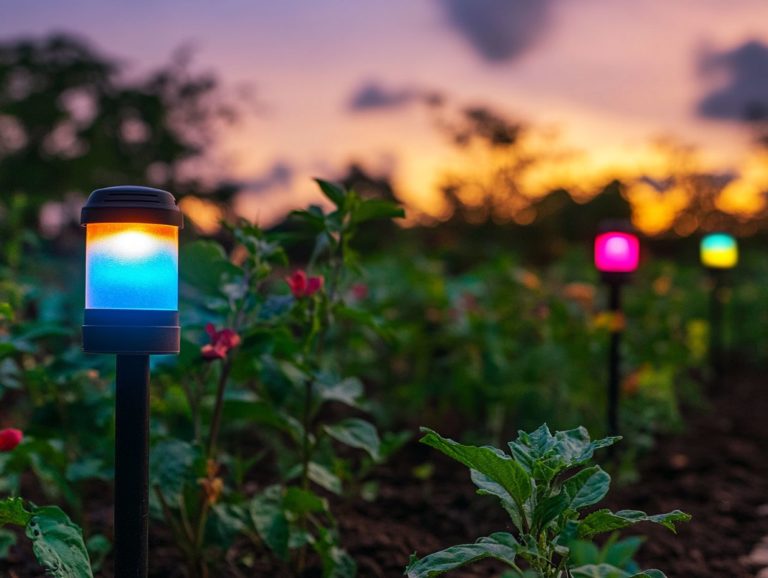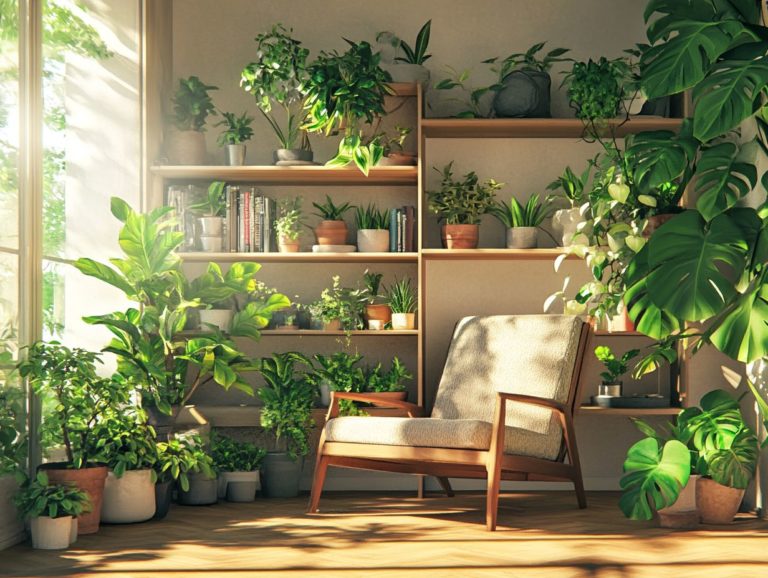The Benefits of Companion Planting Indoors
Companion planting is a time-honored gardening technique that pairs compatible plants to optimize growth, deter pests, and maximize garden space. Regardless of whether you’re an experienced gardener or just beginning your journey, this guide delves into the application of companion planting indoors.
You’ll uncover its historical origins and the multitude of benefits it brings to indoor gardening, such as natural pest control and enhanced plant health. Equip yourself with practical tips for selecting and arranging your plants, and draw inspiration from successful setups that resonate with your personal gardening aspirations!
Contents
- Key Takeaways:
- What is Companion Planting?
- Benefits of Companion Planting Indoors
- How to Implement Companion Planting Indoors
- Examples of Successful Companion Planting Setups
- Frequently Asked Questions
- What is companion planting and how does it benefit indoor gardening?
- Which plants are good companions for indoor gardening?
- How does companion planting help control pests in indoor gardens?
- Are there other benefits of companion planting for indoor gardens?
- Do I need to follow specific planting patterns for companion planting indoors?
- Are there plants that should not be grown together indoors?
Key Takeaways:

- Companion planting indoors is an ancient gardening technique that involves planting different plants together to help them grow better together and maximize yields.
- Natural pest control is a top benefit of companion planting indoors, as certain plants can repel pests and attract beneficial insects.
- By implementing companion planting indoors, you can maximize space and resources, resulting in a more efficient and sustainable garden setup.
What is Companion Planting?
Companion planting is a smart gardening method where you strategically arrange various plants to help them grow better together. This time-honored practice taps into the intricate relationships among plants, enhancing soil health, maximizing yields, and naturally repelling pests.
By identifying both beneficial and detrimental plant pairings, you can cultivate a flourishing ecosystem in your vegetable garden, leading to increased biodiversity. The science behind companion planting highlights the importance of plants that help improve soil quality by adding nutrients and aromatic herbs, which work together to deter pests and attract beneficial insects.
By mastering these plant partnerships, you can achieve healthier gardens and significantly boost your crop production.
Definition and History
The concept of companion planting involves cultivating different plants close together for mutual benefit a practice steeped in agricultural history. This approach dates back thousands of years and showcases a deep understanding of the relationships among various species.
Ancient civilizations, including the Native Americans, recognized the value of growing corn, beans, and squash in harmony, a trio famously known as the “Three Sisters.” Each plant plays a vital role: corn provides a sturdy structure for beans to climb, beans enrich the soil with nitrogen, and squash blankets the ground, suppressing pesky weeds.
As time passed, these techniques evolved, with farmers around the globe uncovering new partnerships that not only boost crop yields but also promote biodiversity. These traditional plant alliances elevate agricultural productivity and nurture a healthier ecosystem, illustrating the timeless wisdom inherent in the art of companion planting.
Benefits of Companion Planting Indoors
Companion planting indoors presents a wealth of benefits that elevate the health and productivity of your indoor garden. By thoughtfully choosing plant partners, you can tap into natural pest control methods, enhance plant growth, and make the most of your limited space!
The harmonious relationships established through companion planting result in robust plants that flourish even in confined environments, reducing pest infestations and encouraging biological balance. Adding flowering plants attracts charming pollinators and beneficial insects, enriching your indoor gardening journey even further.
Natural Pest Control
Natural pest control is one of the most exciting benefits of companion planting. It uses nature s own enemies to combat garden pests through biological control!
By pairing specific plants thoughtfully, you can create a balanced ecosystem that reduces harmful insects. For example, trap cropping involves intentionally growing certain plants to lure pests away from your main crops. A classic example is using radishes to attract cabbage root maggots away from broccoli or cabbage.
Plants like marigolds and basil not only deter pests like aphids and whiteflies, but they also bring in helpful pollinators and friendly insects like ladybugs and lacewings into your garden! These beneficial insects are crucial for managing pest populations organically, boosting your garden s health and yield without using synthetic chemicals.
Improved Plant Growth and Health

Effective companion planting leads to better plant growth and health. By selecting plants that work well together, you help improve soil aeration and nutrient sharing.
Nitrogen-fixing plants, like clover and beans, are essential. They change nitrogen from the air into a form that helps other plants grow. This not only increases soil fertility but also promotes a mutually beneficial partnership where plants thrive together!
Maintaining soil health through these smart partnerships aids in moisture retention and naturally manages pests, leading to a flourishing garden. By nurturing these connections, you can tap into nature’s power for a sustainable and vibrant growth cycle!
Maximizing Space and Resources
Maximizing space and resources is a key advantage of companion planting. This technique allows you to fully utilize limited gardening areas with mixed planting methods!
By pairing plants that complement each other s needs, you can create a thriving ecosystem that boosts crop vitality while making the most of soil nutrients. For instance, try intercropping plant early-season crops like lettuce or radishes with hardy late-season veggies like kale. This not only maximizes your garden space but also improves pest resistance and fights weed growth.
Using resource management techniques like mulching and rainwater harvesting can greatly enhance moisture retention and soil health. This leads to a more sustainable and productive gardening experience!
How to Implement Companion Planting Indoors
Implementing companion planting indoors takes careful planning and thought about compatible plant pairings to create a thriving indoor ecosystem.
Choosing Compatible Plants
Choosing compatible plants is essential for successful companion planting! The right partnerships can boost yields and promote healthier crops.
To do this, consider the growth habits of each variety. Pay attention to height and spread to ensure that taller plants don t overshadow their shorter companions. Some plants, like marigolds, naturally repel pests such as nematodes. They are great companions for tomatoes and various root vegetables.
Research highlights effective plant partnerships like the classic trio of corn, beans, and squash. These plants thrive together, helping each other and improving nutrient uptake and crop resilience. By understanding these interactions, you can create a vibrant ecosystem in your garden!
Arranging Plants for Optimal Growth
Arranging plants for optimal growth is an essential element of companion planting that can determine the success of your indoor garden.
Beyond enhancing aesthetics, the positioning of your plants can significantly influence their health and productivity. When planning your layout, it s vital to consider each species’ light requirements some thrive in direct sunlight, while others prefer the gentle embrace of partial shade.
By thoughtfully grouping shade-tolerant varieties alongside taller plants that provide cover, you can create a microclimate, a specific climate around a small area, that grants each plant the perfect conditions to flourish.
Different plants play unique roles in their ecosystems. Some improve soil health, attract beneficial insects, or even repel pesky pests. If you’re curious about the benefits of having indoor plants, this thoughtful arrangement not only maximizes growth potential but also nurtures a balanced environment, ultimately leading to a more sustainable indoor garden.
Common Mistakes to Avoid

Avoiding common mistakes is essential for achieving success in companion planting, as missteps can significantly undermine the advantages of this effective gardening technique.
One frequent error many gardeners make is overlooking plant compatibility, which can lead to stunted growth or heightened susceptibility to pests. Improper arrangements can disrupt the natural synergy that companion planting aims to create.
For example, positioning sun-loving plants adjacent to shade-tolerant varieties can spark a fierce competition for light, ultimately choking off overall development.
To navigate these pitfalls, it’s important for you to research and understand the specific needs of each plant. Developing planting diagrams and ensuring adequate spacing will foster healthy growth. By implementing these strategies, you can establish a thriving indoor garden ecosystem that flourishes beautifully.
Examples of Successful Companion Planting Setups
Exploring examples of successful companion planting setups offers you valuable insights into how this gardening technique can deliver truly impressive results. By examining these setups, you can uncover the secrets of harmonious plant relationships that enhance growth and productivity in your garden.
Case Studies and Results
Case studies and results from various companion planting experiments illustrate the remarkable effectiveness of this approach in enhancing crop production and managing pests.
In particular, several trials conducted in diverse agricultural settings showcase how specific plant pairings not only elevate overall yields but also foster a more resilient ecosystem.
For instance, when you pair tomatoes with basil, you’ll likely notice a significant boost in tomato yields, while the aromatic oils from basil work their magic in deterring pests like aphids and whiteflies. Additionally, exploring the benefits of indoor gardening can enhance your gardening experience even further.
Similarly, the combination of corn, beans, and squash known as the Three Sisters method by Indigenous agriculturalists demonstrates impressive improvements in soil health and crop support, resulting in healthier plants and bountiful harvests. These insights clearly highlight the tangible benefits of embracing companion planting within sustainable agriculture. Additionally, incorporating indoor plants in your decor can also enhance your environment and well-being.
Considering Your Personal Goals and Needs
Considering your personal goals and needs is vital when it comes to companion planting, as it allows you to craft effective gardening strategies tailored just for you.
This approach maximizes your space and yields while nurturing a healthier ecosystem within your garden. By reflecting on your gardening objectives—whether it’s attracting beneficial insects, minimizing pests, or enhancing soil quality—you can select the ideal plant pairings that resonate with those goals. Additionally, consider the benefits of mulching indoor plant soil to further improve your garden’s health.
It s equally important to customize your setups based on environmental factors, such as your local climate, soil type, and available sunlight, to create a thriving, personalized garden.
Ultimately, the beauty of companion planting lies in its flexibility, giving you the power to make distinct choices that truly elevate your gardening experience.
Frequently Asked Questions
Are you ready to create a thriving indoor garden? Here are some common questions that can guide you:
What plants are best for companion planting? Different combinations work well; for instance, pairing tomatoes with basil is highly beneficial.
How do I know if plants are compatible? Researching plant needs and growth patterns is essential to ensure compatibility.
Can companion planting help with pest control? Yes! Certain plants can naturally repel pests, enhancing your garden’s health.
What is companion planting and how does it benefit indoor gardening?

Companion planting means growing two or more types of plants together to help each other. This technique boosts plant health, increases harvests, and fights pests and diseases indoors.
Which plants are good companions for indoor gardening?
Great pairs for indoor gardening include tomatoes with basil, rosemary with thyme, and marigolds with chives. Always choose plants that grow well together and enjoy the same conditions.
How does companion planting help control pests in indoor gardens?
This practice can keep pests away by masking plant scents or attracting helpful insects. For example, basil near tomatoes can ward off tomato hornworms, while marigolds draw in ladybugs that eat aphids.
Are there other benefits of companion planting for indoor gardens?
Yes! Companion planting improves soil health by attracting beneficial microbes. Some plants even draw pollinators to your garden, which is exciting for your plants!
Do I need to follow specific planting patterns for companion planting indoors?
There are methods like intercropping, where you grow plants close together, and polycultures, where different plants share space. Research what suits your indoor garden best.
Are there plants that should not be grown together indoors?
Absolutely! Some plants, like tomatoes and potatoes, don t grow well together. Others may release harmful chemicals, so be sure to research which plants are compatible.






